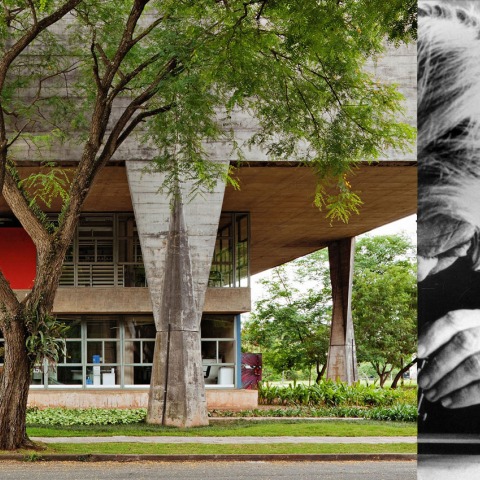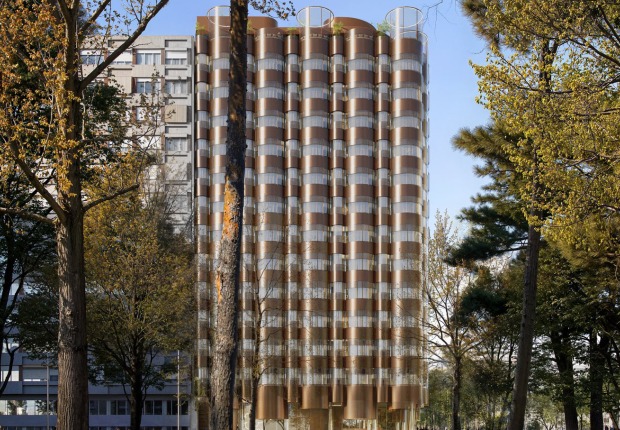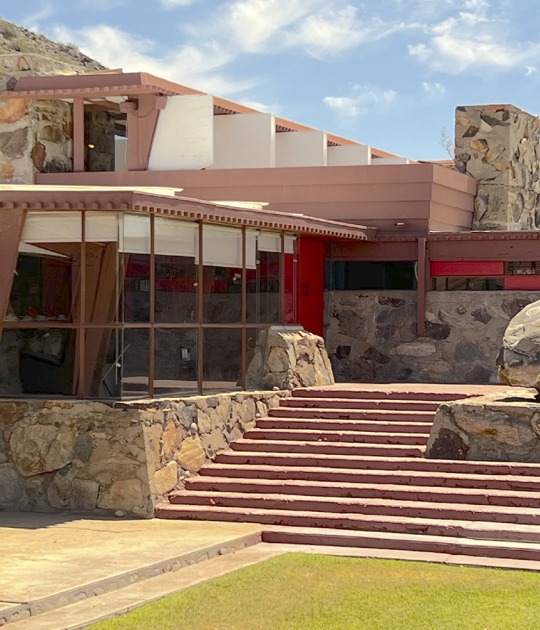Time when didn’t exist yet the exclusive course of architecture. The lack of regulation of the architect profession will represent one more aspect of his militancy, and his performance thereupon will result in substantial transformations in the professional education in this field in Brazil.
In this context, he begins his teaching career in 1940, hired as an assistant professor at the Polytechnic School of São Paulo, where he had previously studied, and a year later became member of the Regional Council of Architecture and Engineering. The teaching and the representation of the profession’s interests prompted him, along with other colleagues, to found the São Paulo’s subdivision of the Institute of Architects of Brazil (IAB-SP). As a direct result of the struggle for recognition of the architect’s work, in 1948 the academic courses of engineering and architecture were made apartand Vilanova Artigas is nominated as one of the organizers of the regulation of the Architecture and Urbanism’s School of the University of São Paulo (FAU-USP).
In parallel to his work in the University and in the Institute, he leads projects in his own professionaloffice and, in his personal sphere, militates for the Communist Party of Brazil (PCB), which he joined in 1945. A political engagement which later on will begin to interweave with his professional life and to be a facet ofhis projects.
In the 1950s, with the upsurge of the Cold War, the growing concern of architects for social issues and of the implications of architecture in it becomes more evident in Brazil. Documents published by Oscar Niemeyer and by Artigas himself make clear this restlessness. The concern for the most vulnerable sectors of society, take place both as regards the attention of material needs - housing and access to urban services - as well as cultural demands - Artigas argued that there was no artisticforms or architecture conceptualization with national traits and popular nature in Brazil:
In this context, he begins his teaching career in 1940, hired as an assistant professor at the Polytechnic School of São Paulo, where he had previously studied, and a year later became member of the Regional Council of Architecture and Engineering. The teaching and the representation of the profession’s interests prompted him, along with other colleagues, to found the São Paulo’s subdivision of the Institute of Architects of Brazil (IAB-SP). As a direct result of the struggle for recognition of the architect’s work, in 1948 the academic courses of engineering and architecture were made apartand Vilanova Artigas is nominated as one of the organizers of the regulation of the Architecture and Urbanism’s School of the University of São Paulo (FAU-USP).
In parallel to his work in the University and in the Institute, he leads projects in his own professionaloffice and, in his personal sphere, militates for the Communist Party of Brazil (PCB), which he joined in 1945. A political engagement which later on will begin to interweave with his professional life and to be a facet ofhis projects.
In the 1950s, with the upsurge of the Cold War, the growing concern of architects for social issues and of the implications of architecture in it becomes more evident in Brazil. Documents published by Oscar Niemeyer and by Artigas himself make clear this restlessness. The concern for the most vulnerable sectors of society, take place both as regards the attention of material needs - housing and access to urban services - as well as cultural demands - Artigas argued that there was no artisticforms or architecture conceptualization with national traits and popular nature in Brazil:
“[…] So long as the connection between architects and the popular masses does not settle or organize, as long as the work of architects has not the glory of being discussed in factories and farms, there will be no popular architecture.” (1)
Stimulated by his political ideology, Vilanova Artigas defended the style of Soviet architecture of the time, called Socialist Realism, until he visited the communist country in 1953. In this trip he was disappointed with the aesthetics and role played by the art and architecture of this current. This fact prompted a professional crisis and generated more doubts about the kind of social action that the architects could promote. According to GuilhermeWisnik (2), this anxiety lasted until Artigas identified himself with the brutalista style some years later. He found in the brutalism an architecture that moved away from the bourgeois refinement and that, in turn, evidenced the process of construction, the structure and, thus, it was believed that it made apparent the performance of the workman of the construction.
In accordance with his political commitment and struggle for quality public education, in the early 1960s, designed a series of school projects for the government of São Paulo and in 1961 drew the new building of the "Architecture and Urbanism’s School of the University of São Paulo (FAU-USP)”, which was built in 1969. He continued teaching at the University of São Paulo and involved in the changes and reformulation of the curriculum of the Architecture’s School until that, with the coup d’etat of 1964, starting the military dictatorship in Brazil, he was arrested and soon exiled in Uruguay. After seven months of exile he returned to Brazil clandestinely, until obtaining the habeas corpus and the acquittal of the legal charges summoned up him.
From this moment, his relationship with the University was somehow troubled and full of interruptions. In the second half of 1965 he returned to his position as teacher at the Architecture’s School. However, in 1969, in the most severe phase of the Brazilian military dictatorship, his right of teaching in the university have been withdrawn and his is banned from the academy. He was not allowed again to teach for about eleven years, until, with the amnesty law in 1979, he returned to school, but as an assistant professor. In 1984, in order to regain the position of full professor, which he was rightful entitled to, he was forced to give an open class in front of a judging commission, as a test, nothwithstang regarded asdishonorable or deeply reproachable as it might be (3). The main theme was "The social function of the architect", an issue to which Artigas dedicated much of his life. The exhibition, despite being attributed like a negative standing for the school, is until nowadays recognized as masterful on the part of Artigas. Vilanova Artigas died a few months later, in 1985.
Appointed as the founder and leader of the "brutalista-paulista" slope or "escolapaulista", his work generate disciples and is admired, respected and studied by architects of later generations. He doesn’t have the same international acknowledgment of other well known Brazilian architects, such as Oscar Niemeyer, but his overall influence at national level is likewise undeniable. His curriculum shows projects that dialogues with the political and social struggles in his times and with the defense of the working class’s aims. Such as projects of trade union’s buildings, social housings, public schools and transports stations, which represent the materialization of a devotion to an architecture aimed towards the interests of the majority of the population. In this sense, Miguel Antonio Buzzar describes him as:
“an humanist, a militant who proposed architecture as a way of transforming society, an architect who defended the truth of materials and stimulated the social function of architecture.” (4)
Defender of the architecture and urbanism of quality for all, he thought of the public spaces through a democratic vision and transferred that urban conception also to the projects of private architecture that developed. Artigas believed that spaces should always have a collective and public character. According to GuilhermeWisnik (5), this is the justification for the consistent uses of raw concrete and ramps, which characterized his projects. The architect used these elements, to be considered of urban character, even in domestic spaces.
NOTES.-
(1) Rosa Artigas e José Tavares Correia de Lira (orgs.). “Vilanova Artigas: caminhos da arquitetura.”. pp 23-55.Owntranslation.Originaltext:“[...] enquanto a ligação entre os arquitetos e as massas populares não se estabelecer, não se organizar, enquanto a obra dos arquitetos não tiver a suma glória de ser discutida nas fábricas e nas fazendas, não haverá arquitetura popular. “
(2) Expressed point of view in interview forthe “Rede TVT”, “ABCD em Revista”. Subject: Vilanova Artigas: O professor da arquitetura social.
(3) Hugo Segawa asserts that the early death of Artigas can not be disconnected from the humiliation of have been undergone to the test at 69 years of age, despite the title being his by right. (SEGAWA, 2002).
(4) BUZZAR, Miguel Antônio. “João Batista Vilanova Artigas: Elementos para a compreensão de um caminho da arquitetura brasileira”. FAU/USP. São Paulo. 1996. Owntranslation. Originaltext: "humanista, um militante que propôs a arquitetura como forma de transformação da sociedade, um arquiteto que defendia a verdade dos materiais e estimulava a função social da arquitetura".
(5) Op. Cit (2)
(2) Expressed point of view in interview forthe “Rede TVT”, “ABCD em Revista”. Subject: Vilanova Artigas: O professor da arquitetura social.
(3) Hugo Segawa asserts that the early death of Artigas can not be disconnected from the humiliation of have been undergone to the test at 69 years of age, despite the title being his by right. (SEGAWA, 2002).
(4) BUZZAR, Miguel Antônio. “João Batista Vilanova Artigas: Elementos para a compreensão de um caminho da arquitetura brasileira”. FAU/USP. São Paulo. 1996. Owntranslation. Originaltext: "humanista, um militante que propôs a arquitetura como forma de transformação da sociedade, um arquiteto que defendia a verdade dos materiais e estimulava a função social da arquitetura".
(5) Op. Cit (2)
BIBLIOGRAPHY.-
ARTIGAS, Rosa y LIRA, José Tavares Correia (orgs.). “Vilanova Artigas: caminhos da arquitetura.”. 4a ed. Publicado originalmente en 1981. Cosac & Naify, São Paulo, 2004.
ARTIGAS, J. B. Vilanova. “O desenho”. 1968.
BUZZAR, Miguel Antônio. “João Batista Vilanova Artigas: Elementos para a compreensão de um caminho da arquitetura brasileira”. FAU/USP. São Paulo. 1996.
CONTIER, Felipe. “O edifício da Faculdade de Arquitetura e Urbanismo na Cidade Universitária: projeto e construção da escola de Vilanova Artigas”. Tesis de doctorado. São Carlos, 2015
KAMIMURA, Rodrigo. “Arquitetura do povo, com o povo, para o povo: teoria e crítica – j. B. Vilanova artigas, sérgio ferro, lina bo bardi”. X Seminário Docomomo Brasil. Curitiba, Brasil. 2013.
PAULA, Zuleide. “João Batista Vilanova Artigas, a edificação do ser e do fazer: um diálogo entre História e Arquitetura“. Revista Patrimônio e Memória, v. 11, n.1, p. 22-45. Unesp, São Paulo. 2015.
Rede TVT. Emisora educativa con videos disponible en YouTube. Serie ABCD em Revista. “Tema: Vilanova Artigas: O professor da arquitetura social.”.
SEGAWA, Hugo. “Arquiteturas no Brasil 1900-1990”. Ed. Edusp. São Paulo. 1999.
SESC TV. Serie de programas publicados en YouTube. “Arquitetura: Faculdade de Arquitetura e Urbanismo FAU/USP”.


































